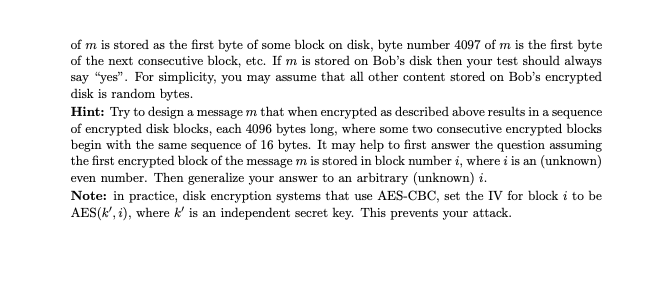Answered step by step
Verified Expert Solution
Question
1 Approved Answer
Problem 4 . Attacks on CBC . a . In class we discussed the ECBC ( encrypted CBC ) MAC for messages in x L
Problem Attacks on CBC
a In class we discussed the ECBC encrypted CBC MAC for messages in where
Recall that RawCBC is the same as ECBC, but without the very last encryption
step. We showed that RawCBC is an insecure MAC for variable length messages. Here we
show a more devastating attack on RawCBC. Let and be two multiblock messages.
Show that by asking the signer for the MAC tag on and for the MAC tag on one additional
multiblock message of the same length as the attacker can obtain the MAC tag on
the concatenation of and
b Let's see a realworld attack on CBC encryption with a predictable IV Suppose Bob uses
AESCBC encryption with key to encrypt blocks on disk, where each block is bytes
long KB the default block size for Linux. Disk block number is CBC encrypted with
key and using an IV equal to the binary representation of This ensures that if two blocks
on disk hold the same data, they result in different ciphertexts. Note that there is no need to
store the IV with the ciphertext because the IV is derived from the block number. Moreover,
if a single file spans multiple disk blocks, then each disk block is AESCBC encrypted on its
own. All disk blocks are encrypted using the same secret key
Suppose an authoritarian regime publishes a subversive video and Bob stores encrypted
on his disk. Later, Bob's machine is seized and the authoritarian regime wants to test if Bob's
disk contains an encrypted copy of if so Bob may have some explaining to do If this
were possible, it would be a serious violation of semantic security.
Show that the regime can create a multiblock video for which it is easy to test if the
encrypted is stored on Bob's disk. You do not know the block number where will be
stored on Bob's disk. However, you may assume that is blockaligned, that is the first byteof is stored as the first byte of some block on disk, byte number of is the first byte
of the next consecutive block, etc. If is stored on Bob's disk then your test should always
say "yes". For simplicity, you may assume that all other content stored on Bob's encrypted
disk is random bytes.
Hint: Try to design a message that when encrypted as described above results in a sequence
of encrypted disk blocks, each bytes long, where some two consecutive encrypted blocks
begin with the same sequence of bytes. It may help to first answer the question assuming
the first encrypted block of the message is stored in block number where is an unknown
even number. Then generalize your answer to an arbitrary unknown
Note: in practice, disk encryption systems that use AESCBC set the IV for block to be
AES where is an independent secret key. This prevents your attack.

Step by Step Solution
There are 3 Steps involved in it
Step: 1

Get Instant Access to Expert-Tailored Solutions
See step-by-step solutions with expert insights and AI powered tools for academic success
Step: 2

Step: 3

Ace Your Homework with AI
Get the answers you need in no time with our AI-driven, step-by-step assistance
Get Started


